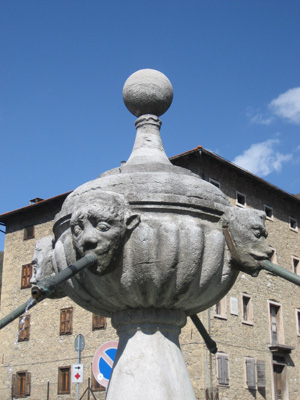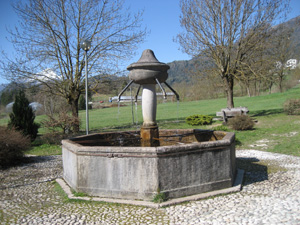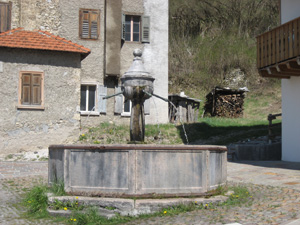| Card n. | Description | Locality | Linked sites |
| 13 | Fountain in Domegge di Cadore | Domegge di Cadore | 149 |
| file .pdf | Architecture Art History (ASA) | Google maps |
 |
 |
 |
- Description
- How to get there
- Interesting facts
- Bibliography
This is probably one of the oldest and largest fountains in the Cadore, of the type featuring a column in the centre that are frequently found in squares, at crossroads and other meeting places. The base and the top of the column are very similar to those found in the fountain in Valle, but the distinguishing feature of the one in Domegge is the large circular basin, dated 1797, the corners of which are reinforced by clearly visible stone pillars. The pod-shaped upper part of the column features four large mascarons with male features, from which emerge four spouts with classic dolphin-head ends. Elsewhere in the municipality of Domegge there are other interesting examples of fountains to be seen, of various types, built in different periods using different kinds of material: in Villagrande di Vallesella there is a simple fountain dated around 1866, originally situated in what was once the village square, repaired in 1999 and placed in the park near the sports field. Also interesting is the fountain in Via Masi in Villapiccola, which has remained in its original setting close to a number of old examples of rural houses, now restored in typical Cadore style. This fountain is dated "1881”, and the mascarons it features have been worn away to a large extent by the infiltrations of water, which have also caused cracks in the central column. The two fountains in Vallesella remain the symbol of a community whose original neighbourhoods disappeared following the destruction of the historical village brought about by a drop in the level of the land: a report from 1565 tells us that meetings took place “above the public square, at the fountain”, which the mayor was compelled to “maintain in good order year after year, using municipal funds for its upkeep….have it restored and renovated so that the supply of water can be guaranteed”.
The fountain of Domegge can be seen in the little square next to the side of the 51bis road, at the beginning of the urban area characterised by stone houses in a style known “Rifabbrico” and opposite Casa Valmassoi, the symbol of the village, featuring a trilobate two-light window and fragments of frescoes.
ACCESSIBLE: yes
MUNICIPALITY: Domegge di Cadore
PLACE: -
GEOGRAPHICAL COORDINATES: X 1762336 – Y 5150889
PROVINCE: Belluno
FILE COMPILED BY: Lonzi
The Hermitage of the Romiti (135 CA), on Monte Froppa, at an altitude of 1164 m, in the municipality of Domegge di Cadore, testifies to the existence of the only convent there was once in the Cadore. It was built in 1720, while the construction of the church dedicated to San Giovanni Battista dates back to 1724. The convent was home to a number of Franciscan friars from the Third Order Regular, and was founded by Friar Giovanni Maria Pinazza, originally from Domegge. The friars who lived on Monte Froppa were known as "the hermits" and their community was suppressed by a decree issued by Napoleon in 1810. Thereafter, the buildings fell into a state of abandon and ruin, until the recent renovation work that has restored the surviving historical elements and built a new tourist facility using bio building techniques and materials, in keeping with the original vocation of the construction. This work was funded by the European Community, in close contact with the Eastern Veneto Superintendence Office for Architectural and Environmental Heritage.
M.S. Guzzon – A. Guzzon, Cadore. Architettura e Arte, Padua, 2008
I. Da Deppo, E. Favero, L’acqua e le sue forme. Lavatoi e fontane del Centro Cadore, Belluno, 2003

